| hawaiisfishes.com |
|
Home |
Fishes | Invertebrates |
Books | CDs
| Links |
Contact |
|
past
fishes of the month HAWAIIAN
SERGEANT
|
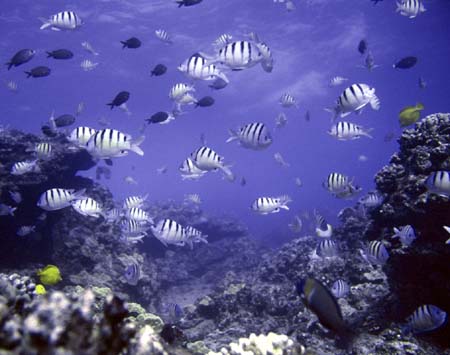 normal schooling coloration - Hanauma Bay, O`ahu |
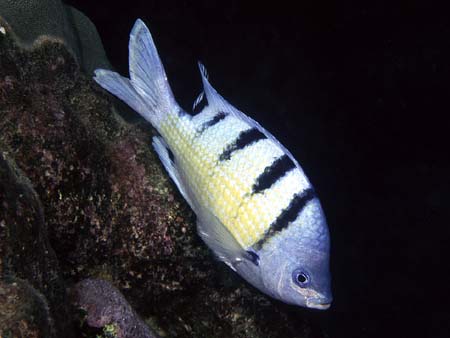 intensified "normal" coloration while guarding nest (male) - Hanauma Bay |
| HAWAIIAN
SERGEANT · mamo Abudefduf abdominalis (Quoy & Gaimard, 1825) These abundant endemics are greenish white with five black bars that extend about half way down the body. The abdomen often develops subtle yellow striping, the bars can lengthen or shorten, and the ground color can lighten or darken. Other color changes occur during spawning and nest-guarding (see below). Juveniles, common in tide pools, are yellowish between the bars. Hawaiian Sergeants are frequently seen swarming high off the bottom to feed on plankton, usually over a specific area of the reef where they shelter and reproduce. When disturbed they dive as one for cover, but soon rise again to resume feeding. In bright sunlight they will feed almost at the surface; when clouds cover the sun they descend somewhat. In addition to plankton, these fish will consume algae or anything else they can find. Males nest in colonies and when reproductively active remain near the bottom vigorously defending purplish red patches of eggs laid on bare rock. The Hawaiian name is from ma'oma'o ("green"). The species name means "abdomen" or "belly" perhaps because this area of the fish is often yellow. The name "sergeant" is shared by several Indo-Pacific and Atlantic species of the same genus and is probably American in origin--sergeants in the British Army wear a crown instead of stripes. To almost 10 in., but usually smaller. Endemic. Photos: Hanauma Bay, O`ahu, unless otherwise noted. |
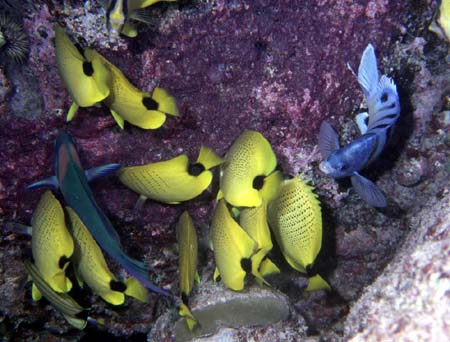 guardian male attempts to drive off egg raiders - Hanauma Bay, O`ahu |
| Come
and get it! Hawaiian Sergeant eggs are a significant food source on the reef. Reproductive males form colonies of up to 120 simultaneously nesting individuals (2-30 are typical) whose nests usually contain large purple-red egg patches laid on bare rock--a conspicuous fat and protein treat for any fishes able to get at them. The nests, typically located on smooth crevice walls, in the spaces between boulders, or on flat hard bottoms, are each guarded by a single male, which valiantly drives off all intruders, or tries to. Although effective against individuals, a defending male Sergeant is no match for an attacking swarm of fish, usually Milletseed Butterflyfish, Raccoon Butterflyfish, or Black Triggerfish, which can easily overwhelm it. Such attacks often happen when a diver is nearby; presumably the close presence of such a large animal distracts the male Sergeant enough to give attackers the edge. Milletseed Butterflyfish know this and may follow divers considerable distances until a Sergeant nesting area is reached. Once a Milletseed attack has begun, wrasses, other butterflyfishes, triggerfishes, filefishes, and even other Sergeants join in, creating a colorful feeding frenzy that lasts several minutes or more. The frantic male darts back and forth trying to repel the raiders, often intensifying or changing his colors as he does so. The swarm, having eaten its fill, eventually responds to its efforts and moves on. Usually plenty of eggs are left and the Sergeant resumes his duties. One can only wonder why Sergeant eggs are so conspicuous when most damselfish eggs are hardly noticeable. Perhaps they play some important role in the ecology of the reef. See also the Pacfic Gregory end section. |
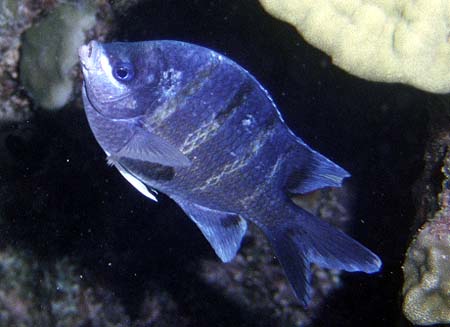 male showing dark aggressive coloration - assumed while defending nest or courting - Kahe Point, O`ahu. |
|
Hawaiian
Seargeant Reproduction |
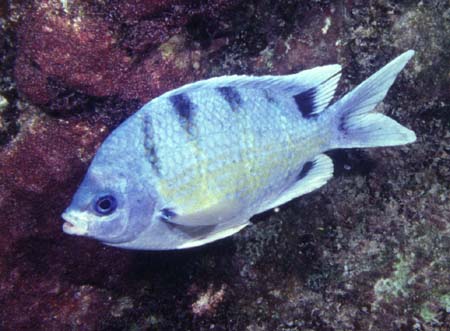 male showing light aggressive coloration - assumed while defending nest or courting - Hanauma Bay, O`ahu. |
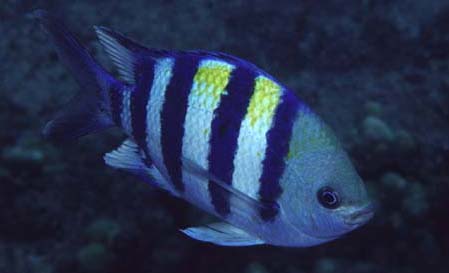 Indo-Pacific Sergeant - close relative of the Hawaiian Sergeant - Kahe Point, O`ahu. |
| Origins The Hawaiian Sergeant probably descended from the Indo-Pacific Sergeant, A. vaigiensis, (above) a species widespread in the Indo-Pacific outside Hawai`i. Until about 1990 the Indo-Pacific Sergeant was unknown in the Islands; it has somehow been introduced (perhaps drifting in with abandoned fishing gear) and now almost always occurs in small numbers wherever the Hawaiian species is present. The two species do not appear to be interbreeding. The Indo-Pacific Sergeant sports bright yellow on its back and has longer, broader, darker bars than the Hawaiian Sergeant. |
|
Home | Fishes | Invertebrates | Books | CDs | Links | Contact Text and photos copyright John P. Hoover |